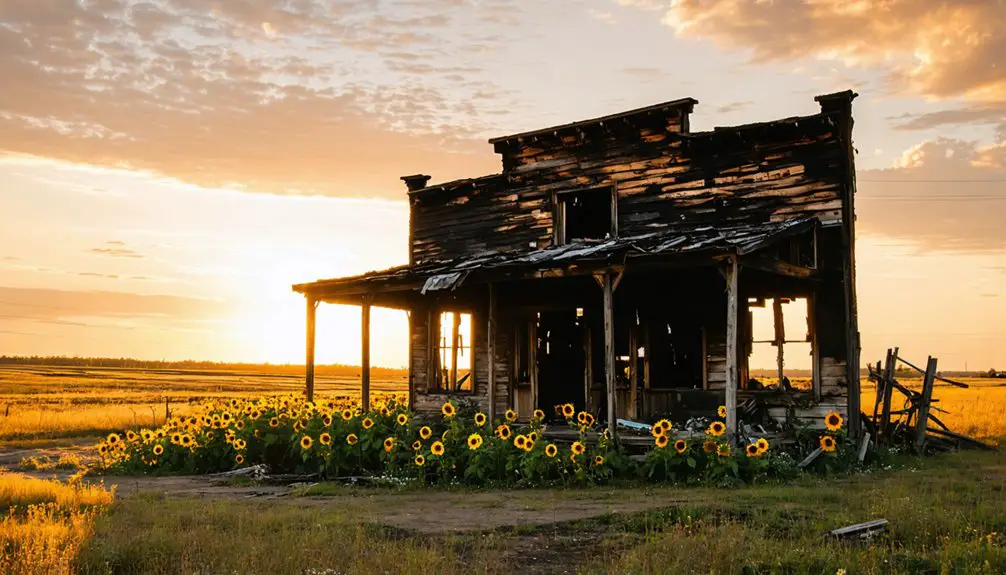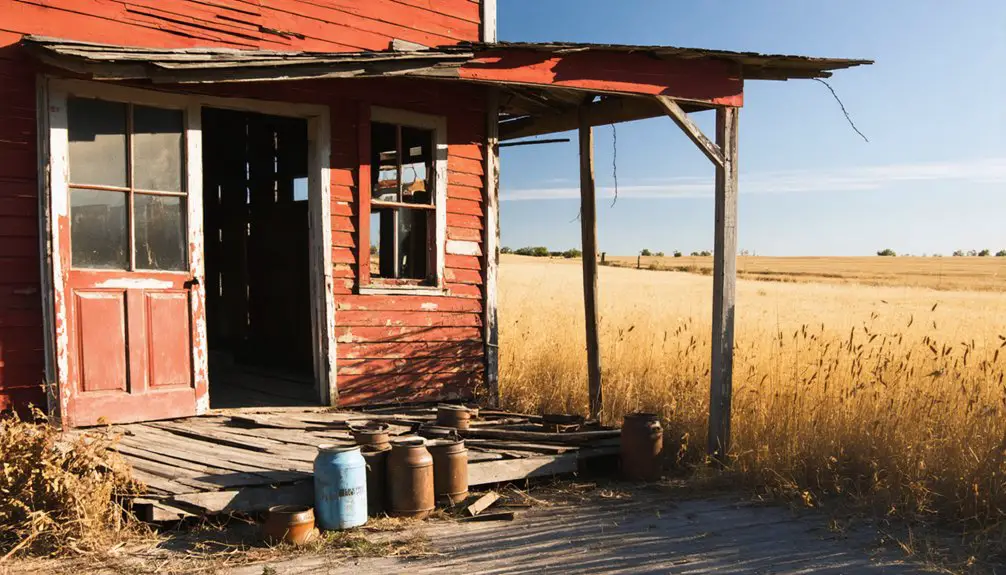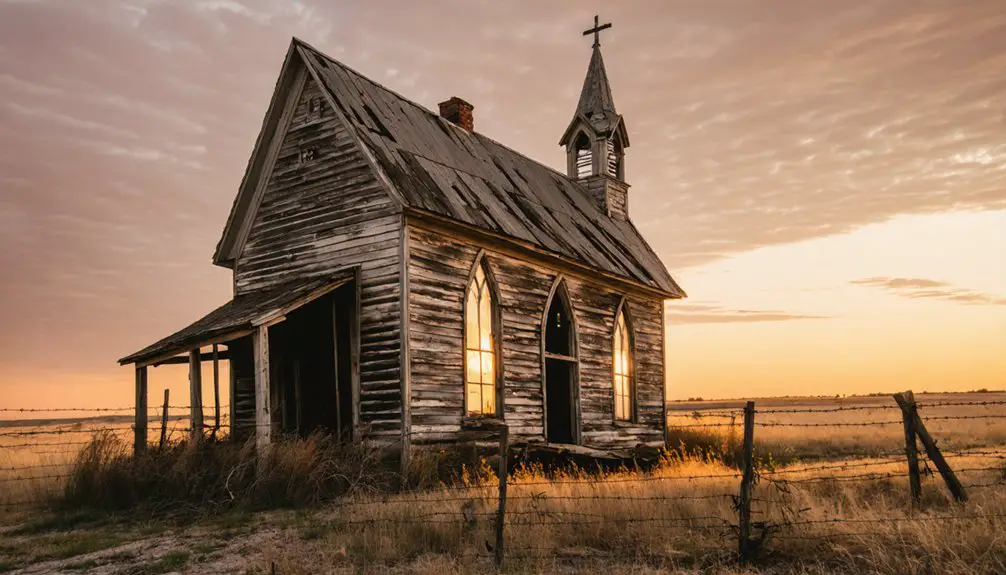You’ll find Sitka, Kansas, nestled along the Oklahoma border, where the Atchison, Topeka and Santa Fe Railway once fueled this bustling frontier town. From its early days as a trading post to its peak population of 559 in 1916, Sitka thrived with stockyards and grain elevators serving the region’s commerce. A catastrophic fire in the 1950s devastated the commercial district, leading to the town’s abandonment, with the final train departing in 1994. The remaining sidewalks and foundations tell a compelling frontier tale.
Key Takeaways
- Sitka was a thriving Kansas railroad town that peaked at 559 residents in 1916 before declining into abandonment.
- The town’s economy centered around its stockyard and grain elevator, supported by the Atchison, Topeka and Santa Fe Railway.
- A devastating fire in the 1950s destroyed Sitka’s commercial district, accelerating the town’s eventual abandonment.
- The last train departed in February 1994, marking the final chapter in Sitka’s history as a functioning community.
- Today, only sidewalks, foundations, and a water pump remain as physical evidence of this once-prosperous Kansas town.
Early Days and Railroad Influence
When the railroad arrived in Sitka Township, Kansas, it sparked a period of rapid growth that would see the community reach its peak population of 559 residents by 1916.
If you’d explored Sitka’s history during this railroad expansion era, you’d have found a bustling town situated just four miles north of the Oklahoma border. The railroad transformed Sitka into a significant economic hub, complete with an impressive stockyard serving both Kansas and Oklahoma businesses. Much like in Ottawa, Kansas, where the Leavenworth, Lawrence & Galveston railroad drove development, Sitka’s growth was deeply tied to rail transportation. A devastating fire in the 1950s destroyed many of the town’s key businesses and structures.
You’d have witnessed the town’s strategic position near “No Man’s Land” – a lawless territory roughly 50 miles south of Dodge City – which added complexity to local commerce and social dynamics. The railroad’s presence meant you could ship livestock and agricultural products to distant markets, making Sitka a crucial transportation link for the region’s economic activity.
Life Along the Oklahoma Border
Located just north of the Oklahoma border, Sitka found itself uniquely positioned as both a railroad stop and a gateway to the notoriously lawless Oklahoma Panhandle during the late 1800s.
You’d find a mix of legitimate traders and suspicious characters passing through town, as Sitka served as the last regulated stop before entering the ungoverned 34.5-by-167-mile strip known as “No Man’s Land.”
The town’s proximity to this jurisdictional void created constant challenges for local law enforcement, who’d to maintain order while contending with outlaws who could easily slip across the border to escape Kansas authorities.
This lawless period finally ended when the Organic Act of 1890 assigned the Public Land Strip to Oklahoma Territory, bringing much-needed governance to the region.
Today, the town sits along US-183 and US-160, marking its historical significance as a transportation junction between states.
Border Trade and Commerce
Three major trading routes shaped the economic destiny of Sitka, Kansas – the Santa Fe Trail, Chisholm Trail, and later the Santa Fe Railway. These border routes directed commerce southwest toward Oklahoma rather than northeast, establishing crucial trade networks between settlers and Native American tribes. The Columbian Exchange dramatically altered trade patterns by introducing new crops and technologies to the region.
You’d find a rich variety of trade goods moving through the area: furs, food, blades, tobacco, coffee, weapons, gunpowder, and animal pelts. French traders, who’d established posts around 1719, often married into Native tribes, creating strong commercial alliances. Traders operated out of crude dog-trot cabins with open breezeways between two enclosed areas, making the best of frontier conditions.
The indigenous peoples traded hides, cotton cloth, feathers, and shell beads in return. By 1872, the arrival of refrigerated railroad cars revolutionized the region’s commerce, though the earlier trails had already established lasting trade patterns that influenced Sitka’s development along the Oklahoma border.
Law Enforcement Challenges
Despite federal oversight of immigration enforcement, law enforcement agencies along the Kansas-Oklahoma border faced complex jurisdictional challenges that strained local resources and community relations.
You’d find local police departments struggling with limited staffing and funding while being pressured to participate in federal immigration tasks through 287(g) agreements. This created tension between state and federal authorities, particularly as Oklahoma officials pushed for expanded state powers in response to perceived federal failures. Attorneys general from twenty-two different states joined forces to challenge federal limitations on immigration enforcement.
In communities near Sitka, you’d see how these challenges affected public safety. Local officers’ involvement in immigration enforcement often damaged community trust, especially among immigrant populations who’d avoid reporting crimes or accessing municipal services for fear of deportation. Sheriff Jeff Easter pointed out the lack of federal officials made widespread immigration enforcement nearly impossible to implement effectively.
This made effective policing more difficult and left both citizens and immigrants vulnerable.
Railroad Stop Activities
While law enforcement challenges shaped border dynamics, the railroad’s influence near Sitka, Kansas painted a different picture of life along the Oklahoma border.
You’d find Sitka’s residents making the most of nearby transportation routes, even though their town wasn’t a major railroad stop. Local farmers relied on these rail connections to move their agricultural goods, with the town’s elevator serving as an essential hub for commerce. Similar to coal transportation lines that connected Peterton to Topeka, these railways were vital for the region’s economic growth.
The railroad history of the region directly impacted Sitka’s fortunes, reaching a peak population of 559 in 1916. The last train departed in February 1994, marking the end of an era for the community.
You could witness trains passing through the area, facilitating trade between Kansas and Oklahoma territories. While other towns with major stops eventually overshadowed Sitka, the rail lines remained significant to the community’s agricultural economy and regional connections.
Economic Rise and Fall
As the Atchison, Topeka and Santa Fe Railway arrived in the early 20th century, Sitka transformed from a small rural settlement into a bustling commercial hub in Clark County, Kansas.
You’d have seen remarkable economic resilience as the town’s stockyards connected traders from Kansas to Oklahoma, while the railway depot facilitated both passenger and freight transport.
The community’s adaptation to changing markets initially proved successful, with the grain elevator and stockyards driving prosperity through the 1950s.
But you wouldn’t recognize Sitka today. The town’s fortunes declined as automobile travel replaced rail service, nearby communities siphoned business away, and agricultural markets consolidated.
The Devastating 1950s Fire

In rural Sitka, Kansas, a devastating fire in the 1950s destroyed most of the town’s wooden structures and essential businesses, marking a turning point in the community’s history.
You’ll find that the town’s isolation and lack of local firefighting resources allowed the flames to spread unchecked through the settlement, as the nearest emergency services couldn’t respond in time.
The fire’s destruction proved insurmountable for this small prairie town, accelerating its decline into abandonment as residents left and businesses never reopened.
Fire’s Initial Impact
During the 1950s, a catastrophic fire swept through Sitka, Kansas, decimating most of the town’s essential commercial district and infrastructure.
The fire dynamics proved especially destructive due to the prevalence of wooden buildings typical of rural Kansas communities, allowing flames to spread rapidly through the business district.
You’ll find that without a nearby fire department, the town’s community resilience was severely tested as emergency response times were drastically delayed.
The devastation left Sitka’s crucial railroad and livestock operations crippled, while destroying most main street businesses that served as the town’s economic backbone.
Critical services and social gathering places vanished in the flames, forcing many residents to relocate.
Only a few structures, including the grain elevator, survived the inferno that would ultimately transform Sitka into a ghost town.
Inadequate Emergency Response
The inadequate emergency response capabilities of 1950s Sitka sealed the town’s fate when disaster struck.
You’d find a woefully unprepared volunteer fire department lacking both training and equipment to battle major fires. With outdated trucks struggling down poorly maintained roads, and no modern alarm systems, precious minutes were lost as the flames spread.
The town’s emergency preparedness was virtually non-existent, with no evacuation plans or organized shelters.
When you consider the perfect storm of challenges – limited water supplies, insufficient protective gear, and broken communication systems – it’s clear why the response fell short.
The community’s resilience was tested as crews fought against dry, windy conditions without proper meteorological data or firefighting chemicals.
Support from neighboring towns arrived too late, hampered by Sitka’s remote location and lack of mutual aid agreements.
Town Never Recovered
When flames engulfed Sitka’s wooden structures in the 1950s, you’d have witnessed the beginning of this Kansas town’s final decline. The devastating fire wiped out most businesses, including the essential railroad-connected stockyard that had extended commerce into Oklahoma.
Without its core economic infrastructure, Sitka’s community resilience crumbled.
You’ll find evidence of urban decay in the haunting remnants – sidewalks that lead nowhere and abandoned buildings slowly returning to prairie. While the grain elevator survived, the town’s once-bustling social centers and gathering places vanished.
The combination of fire damage, regional competition, and the broader challenges facing rural communities proved insurmountable. Sitka never rebuilt its business district or recovered its population, ultimately cementing its fate as a ghost town in Clark County.
Historical Landmarks and Lost Architecture

At its peak in the 1920s, Sitka’s Main Street bustled with architectural landmarks that defined this small Kansas town’s character.
Small-town Kansas bustled with life in the 1920s, as proud architectural landmarks lined Sitka’s thriving Main Street.
You’d have found the Lackey store, city hotel, Home Lumber and Supply Co., and Reed’s service station lining the streets, each building contributing to the town’s architectural significance.
A devastating fire in the 1950s forever changed Sitka’s landscape.
Without a fire department to protect these historic structures, the blaze consumed many of the town’s important buildings.
What’s left today speaks volumes about the challenges of historical preservation in rural Kansas – an old elevator stands as the last operating business, while a solitary water pump in a pasture and scattered foundations hint at the vibrant community that once called this place home.
Preserving Sitka’s Legacy
Preserving Sitka’s legacy presents unique challenges in rural Kansas, where physical remnants of this once-thriving railroad town continue to deteriorate.
You’ll find traces of the past in remaining sidewalks, foundations, and a water pump, while community storytelling keeps memories alive through tales of the renowned Sitka Social Club‘s legendary steaks and burgers.
Thanks to Eldora McMinimy’s published history and various online archives, you can explore Sitka’s story through photographs, maps, and documented accounts.
Heritage tourism opportunities exist as you walk the original main street, though preservation efforts face obstacles due to the town’s isolation and limited resources.
While a devastating fire in the 1950s destroyed much of the business district, local oral histories and physical documentation guarantee that Sitka’s contributions to Kansas history won’t be forgotten.
Frequently Asked Questions
Are There Any Remaining Residents Living in Sitka Today?
With just 44 current residents, you’ll find a small but resilient community living in this near-ghost town. Most are spread across 13 households, with 62% being homeowners who’ve stayed despite declining numbers.
What Native American Tribes Originally Inhabited the Sitka Area?
You’ll find that the Kanza, Osage, Pawnee, and Comanche tribes shaped the tribal history of this region, with the Kanza maintaining particularly significant cultural significance through their settlements and treaties nearby.
Did Any Famous Outlaws Pass Through or Hide in Sitka?
Like tumbleweeds in the wind, outlaw legends drift through Sitka’s historical significance, but you won’t find concrete evidence of famous outlaws there – just its proximity to No Man’s Land brought drifters through.
What Was the Peak Population of Sitka During Its Most Prosperous Years?
You’ll find that among Kansas ghost towns, Sitka reached its historical significance with 300 residents during the prosperous 1920s, when agriculture and railway activity fueled the town’s peak population.
Were There Any Significant Archaeological Finds or Artifacts Discovered in Sitka?
Like scattered breadcrumbs from the past, you’ll find archaeological discoveries are limited, with few historical artifacts from pioneer times beyond a small cemetery and remnants from an 1880s settlement.
References
- https://www.youtube.com/watch?v=HpolfSLrhsE
- https://www.youtube.com/watch?v=gkfXLg-ftys
- http://kansasghosttowns.blogspot.com/2010/10/sitka-kansas.html
- https://www.youtube.com/watch?v=PfThSLZOtqg
- https://legendsofkansas.com/kansas-ghost-town-list/
- https://dianastaresinicdeane.wordpress.com/2012/06/12/ghost-trains-on-the-low-plains-a-kansas-railroad-story/
- https://capitalpress.com/2010/10/29/kansas-town-slowly-fades-from-state-history/
- https://en.wikipedia.org/wiki/U.S._Route_183_in_Kansas
- https://en.wikipedia.org/wiki/Oklahoma_panhandle
- https://www.youtube.com/watch?v=Pf5n1PX1g3M



